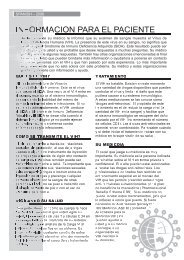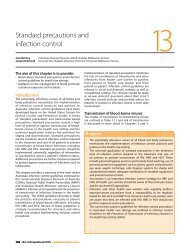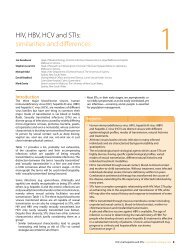B Positive – all you wanted to know about - ASHM
B Positive – all you wanted to know about - ASHM
B Positive – all you wanted to know about - ASHM
You also want an ePaper? Increase the reach of your titles
YUMPU automatically turns print PDFs into web optimized ePapers that Google loves.
3 Hepatitis B virus testing and interpreting test results<br />
testing usu<strong>all</strong>y involves evaluation of Hbsag<br />
and anti-Hbs. alternatively, anti-Hbc can also<br />
be tested, but needs follow-up with Hbsag<br />
and anti-Hbs testing. if Hbsag is positive, then<br />
further investigation is appropriate with anti-<br />
Hbc, Hbeag, anti-Hbe and aLt. HbV dna assays<br />
are now available and should be used in the<br />
assessment and management of <strong>all</strong> patients<br />
with HbV infection.<br />
Pre-test and post- test<br />
discussion<br />
Providing support and information <strong>about</strong> the<br />
HbV testing procedure assists in minimising<br />
the personal impact on the patient of a positive<br />
diagnosis, changing health-related behaviour<br />
and reducing anxiety. Pre-test and post-test<br />
discussion forms an integral part of testing<br />
and should be relevant <strong>to</strong> the patient’s gender,<br />
cultural beliefs and practices, behaviour and<br />
language. 27 this includes considering local<br />
and cultural issues such as stigma, shame and<br />
concerns around confidentiality.<br />
Pre-test discussion<br />
the key points <strong>to</strong> be discussed during pre-test<br />
discussion for HbV include:<br />
� risk assessment and reasons for testing<br />
� information <strong>about</strong> prevention and risk<br />
reduction<br />
� confidentiality and privacy<br />
� testing process and window period<br />
� seeking informed consent<br />
� implications of a positive and negative<br />
result<br />
� Medical consequences of infection<br />
� support mechanisms whilst waiting for test<br />
results and if result is positive<br />
While not <strong>all</strong> these issues may be relevant <strong>to</strong><br />
every patient, assumptions <strong>about</strong> the patient’s<br />
<strong>know</strong>ledge and risk practices should be<br />
avoided. the pre-test discussion ensures that<br />
prevention measures are in place, the patient<br />
is prepared for his/her test results, and the<br />
clinician’s ethical and legal responsibilities have<br />
been met.<br />
table 3.3 provides a summary of the key points<br />
<strong>to</strong> be addressed in the pre-test discussion.<br />
36 b <strong>Positive</strong> <strong>–</strong> <strong>all</strong> <strong>you</strong> <strong>wanted</strong> <strong>to</strong> <strong>know</strong> <strong>about</strong> hepatitis b: a guide for primary care providers<br />
table 3.3 summary of HbV pre-test<br />
discussion<br />
� reason for testing and risk assessment<br />
� timing of risk and option of post-exposure<br />
prophylaxis (PeP)<br />
� need for other sti and blood-borne virus<br />
testing<br />
� His<strong>to</strong>ry of testing<br />
� confidentiality and privacy issues around<br />
testing<br />
� ensuring there is informed consent for the<br />
HbV test<br />
� natural his<strong>to</strong>ry of HbV and HbV<br />
transmission information (if appropriate)<br />
� Prevention of transmission and risk<br />
reduction through behaviour change<br />
� implications of a positive or indeterminate<br />
test result, including availability of<br />
treatment<br />
� implications of a negative test result<br />
� explanation of the window period<br />
� General psychological assessment and<br />
assessment of social supports in the event<br />
of a positive result<br />
� Logistics of the HbV test: time taken for<br />
results <strong>to</strong> become available and the need<br />
<strong>to</strong> return for results<br />
Post-test discussion<br />
<strong>all</strong> HbV test results must be given in person.<br />
as outlined for the pre-test discussion, giving<br />
a test result should also be conducted in a<br />
manner that is confidential, sensitive and<br />
appropriate <strong>to</strong> gender, cultural beliefs and<br />
practices, behavior, ongoing risk and language.<br />
the post-test discussion should be conducted<br />
where privacy is assured and where there will<br />
be no interruptions.<br />
Giving a positive result<br />
the key points <strong>to</strong> be discussed in relation <strong>to</strong><br />
delivering a positive result and subsequent<br />
consultations have been summarised below<br />
(table 3.4). in addition <strong>to</strong> the post-test<br />
discussion, patients newly diagnosed may<br />
benefit from the provision of written material






